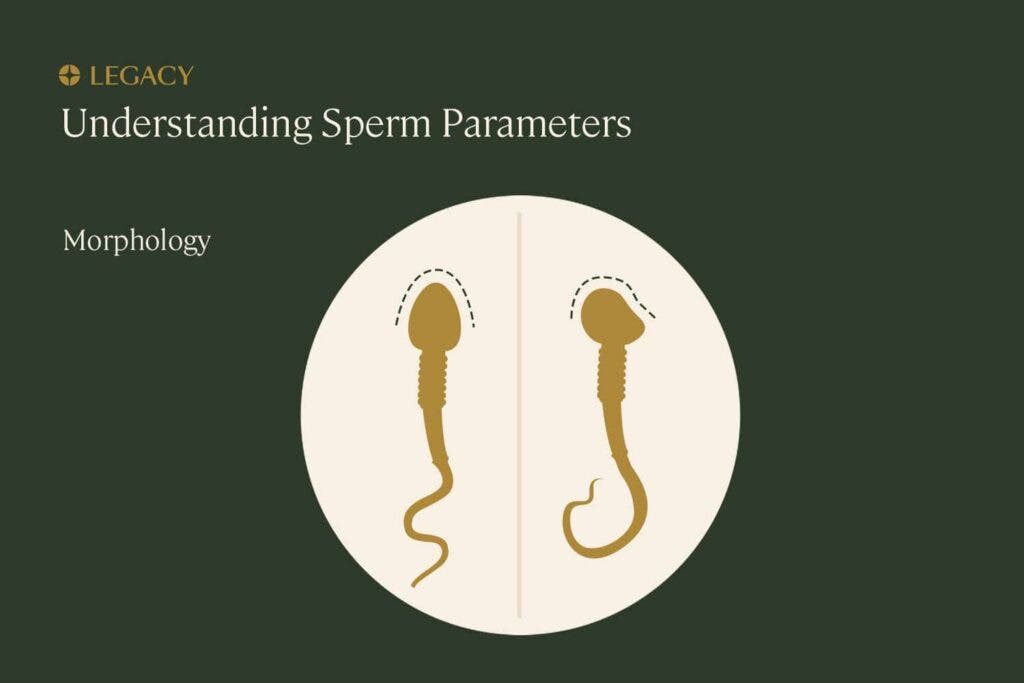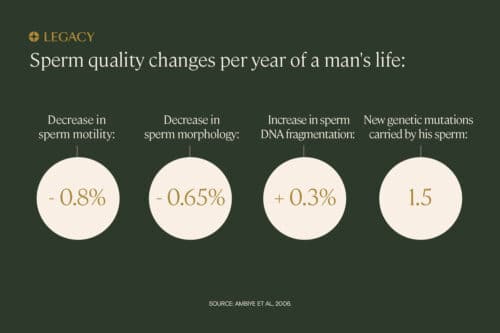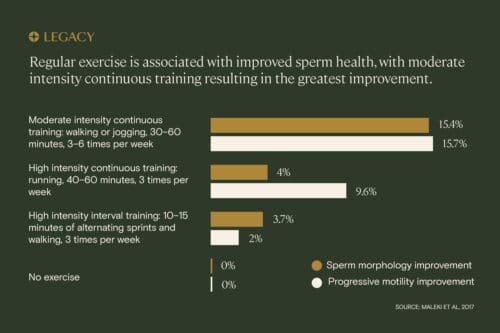If you’ve considered testing your fertility, one of the frontline male fertility tests is a semen analysis. This analysis will give you insight on five important factors that measure your fertility, and one of those factors is sperm morphology. Here, we cover what morphology means, how it affects male fertility, and the steps you can take to improve your sperm morphology.

What is sperm morphology?
Sperm morphology refers to the shape, structure, and size of sperm. When you get a semen analysis, sperm morphology is an important fertility factor analyzed. During this assessment, the sperm is examined under a microscope to determine the ratio of normal to abnormal sperm. Sperm morphology is measured by a percentage of “normal forms,” sometimes abbreviated to NF, or “normal sperm.”
It’s important to note that even healthy, fertile men will produce a high percentage of abnormal sperm. Many men get results that demonstrate over 50% of their sperm produced is abnormal in shape or size—that ratio is completely typical.
Trying to conceive?
Find out which sperm test is best for you.
Get started

Trying to get pregnant?
Find out which sperm test is best for you.
Get started

Why is sperm morphology important?
A sperm’s shape affects its ability to move efficiently, and to reach and fertilize the egg. Although some men with abnormal sperm morphology have conceived naturally, studies show that infertile patients tend to have a significantly lower sperm morphology.
Another study followed two groups of men: those with a 0% normal forms, and those with a 4% or greater normal forms. Less than a third of men with 0% NF were able to conceive naturally, compared to 55.6% of men with normal ranges of sperm morphology.
While abnormal sperm morphology may indicate that conception could be a challenge, it doesn’t completely rule it out. In the study mentioned above, even men with 0% NF were in some cases able to get their partners pregnant. And a study of over 500 couples undergoing intrauterine insemination (IUI) found that sperm morphology did not impact pregnancy rates.
So, if it’s possible to conceive with abnormal sperm morphology, why is it important? The majority of studies, including the two noted above, show a strong correlation between higher ranges of normal forms and successful pregnancy. This is why most physicians agree that sperm morphology is an important factor in the overall male fertility picture, and why it is measured in a semen analysis.
Normal vs. abnormal sperm morphology
Underneath the microscope, medical experts and physicians look for the following visual parameters.

Normal sperm morphology
A normal sperm has:
- A smooth, oval-shaped head that is approximately 5–6 micrometers long and 2.5–3.5 micrometers wide.
- A well-defined cap, called an acrosome, that covers the majority (40–70%) of the sperm head. (The acrosome contains enzymes that help the sperm penetrate the egg for fertilization.)
- A midpiece or body that contains mitochondria to power the sperm.
- A tail made up of protein fibers that helps the sperm move toward the egg.
A normal sperm should also have no visible abnormalities on the neck, midpiece, or tail.
Learn more about sperm anatomy.
Abnormal sperm morphology
Abnormalities in a sperm’s shape and size can make it more difficult to penetrate and fertilize an egg. Examples of common abnormalities include:
- Tail bent at an angle greater than 90º.
- Coiled or multiple tails.
- Tails that are too short or too long.
- Multiple heads on a single sperm.
- Elongated or misshapen head.
- Sperm head detached from tail.
Testing for sperm morphology
Morphology is tested as part of a semen analysis, often the first line of male fertility testing. Typically, the semen sample is stained to allow for easier visualization of the sperm, which are then evaluated, one by one, under a high-powered microscope. The morphology “score” is calculated by determining the percentage of normal sperm from the total number of sperm assessed.
There are two guidelines used for morphology testing: the Kruger strict criteria and the World Health Organization (WHO) criteria. Because these use different methods to determine whether sperm is normal or abnormal, they may affect the way your results can be interpreted.
The Kruger criteria is very strict, and results under 14% NF may be considered abnormal. The World Health Organization (WHO), on the other hand, has slightly less strict guidelines for judging sperm. Using these criteria, the lower threshold for normal morphology is 4%.
Remember, while sperm morphology is important, it’s also just one piece of the fertility puzzle. When you get a semen analysis done, you can take a look at your sperm morphology along with all of the other important factors related to male fertility, like sperm count, concentration, and motility.

What affects sperm morphology?
Multiple factors, from genetics to lifestyle to environment, can affect your sperm morphology and overall sperm quality. Below are some of the most common factors that have an impact on sperm morphology.
Age
Sperm morphology tends to decrease as you age. Studies show a decline in normal sperm morphology of 0.2–0.9% per year of age. The annual decline is minimal but over a 20-year period, that adds up to a 4–18% decrease in normal sperm.

Lifestyle
Your lifestyle plays a significant role in your fertility. Factors like smoking, drug and alcohol consumption, diet, exercise, weight, sleep and stress may all impact your sperm morphology.
For example, studies have found that the common “Western” diet—high in fried foods, refined grains, added sugars, and red meat—as well as diets high in processed meats, such as hot dogs and cold cuts, are associated with lower sperm morphology.
Physically active men have been shown to have improved sperm morphology, along with other semen parameters and healthier hormone profiles for fertility, compared to their more sedentary counterparts.
Smoking has long been considered one of the leading risk factors in male infertility, and a 2019 review found a strong correlation between smoking and poor sperm morphology.
Toxin exposure
Multiple studies that analyze human exposure to environmental toxins suggest a negative impact on semen quality, including sperm morphology. Men with certain occupations may be more regularly exposed to toxins and chemicals that can impact their fertility, including those who work in agriculture (dealing with herbicides and pesticides), welding (exposure to metal), or in plastic production (handling petrochemicals or solvents).
How to improve sperm morphology
There are some factors affecting sperm morphology that we cannot control, like age or genetics. But if you discover that your sperm morphology is abnormal, making positive lifestyle changes can be associated with significant improvements to sperm health.
A nutrient-rich diet and regular exercise can help improve your sperm morphology, and is something you can take one day at a time. Try incorporating these six superfoods for male fertility into your diet.
Get tips to optimize sperm health so you can achieve your parenthood dreams.
Exercise may help, too, especially if you have excess weight. One study demonstrated that a training program consisting of hour-long treadmill workouts three times per week lead to improvement in the sperm morphology of obese patients. Try to add moderate-intensity workouts into your routine a few times a week—swimming, walking, jogging, and aerobics are great forms of physical activity for sperm health.

To help improve your sperm quality, it’s also advised to quit smoking. In one follow-up study of men who quit smoking, sperm morphology began to return to normal within an average of six months.
Finally, you might consider male fertility supplements to support sperm morphology. Fenugreek, folate, and antioxidants such as CoQ10, selenium, vitamin E, and vitamin C all have some evidence to support their use for improving sperm morphology.
Getting answers on sperm morphology: how to get a sperm analysis
Sometimes, taking the first step to assessing your fertility can feel like a challenge. Where do you go? How much will it cost? Do you need to see a doctor first?
Legacy’s at-home sperm analysis kit provides you with a clear, easy-to-understand report of your sperm morphology and overall fertility. There’s no question that fertility is a highly personal subject. Taking a test at home empowers you to get the insight you need, on your terms.